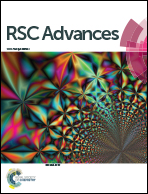Nanoscale investigations on β-phase orientation, piezoelectric response, and polarization direction of electrospun PVDF nanofibers
Abstract
A single stage far-field electrospinning process can give rise to β-phase nanocrystals preferentially oriented in polyvinylidene fluoride (PVDF) nanofibers. The polymer chains in the as-electrospun PVDF nanofibers was oriented along the fiber axis as visualized at atomic scale through high resolution TEM and the β-phase content was found to be 72.7%. The vector mapping of piezoelectricity was investigated on piezoelectric responses in different directions via advanced piezoresponse force microscopy (PFM). It turns out that the piezoelectricity of the PVDF nanofibers is mainly derived from the out-of-plane (OP) electric-to-mechanical conversion. The PVDF nanofibers result in an average OP piezoelectric constant (d33) of −25.3 pm V−1. The β-phase polarization of the nanofibers is oriented at a small inclination to the z-axis (almost perpendicular to the fiber axis and the bottom electrode).


 Please wait while we load your content...
Please wait while we load your content...